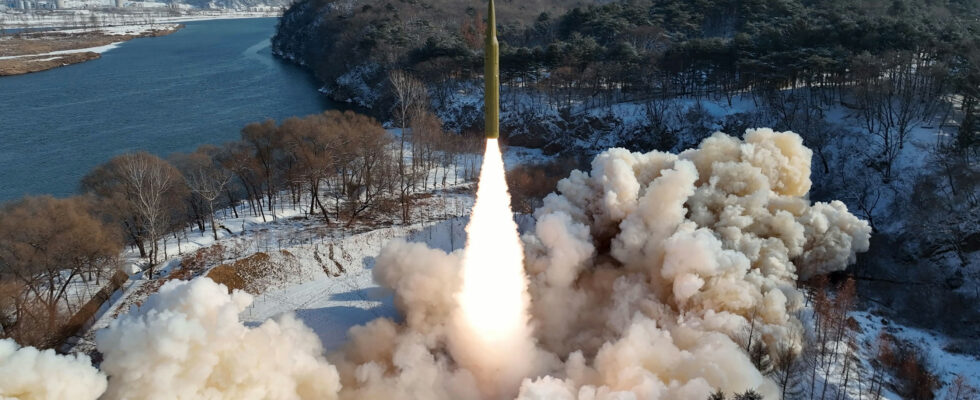North Korea announced Monday that it had successfully fired a new type of ballistic missile equipped with a maneuverable hypersonic warhead, a new technological advance in weapons. This firing, the first of a solid-fueled hypersonic intermediate-range ballistic missile (IRBM) by Pyongyang, was detected by the South Korean military on Sunday afternoon.
This solid-fuel missile was “loaded with a hypersonic and maneuverable warhead”, according to the North Korean state news agency KCNA. The test was intended to “verify the gliding and maneuverability capabilities” as well as “the reliability of the newly developed high-thrust, multi-stage solid fuel engine,” KCNA explained.
The agency said the launch, the first reported by Pyongyang since the start of the year, “has never affected the security of any neighboring country and has nothing to do with the regional situation.” This test comes against a backdrop of concerns around a hardening of Pyongyang’s position. Last week, North Korean leader Kim Jong Un described South Korea as the country’s “main enemy” that he would not hesitate to “annihilate.”
South Korea’s Defense Ministry condemned the launch and said it would result in a “crushing response” in the event of a “direct provocation” from Pyongyang.
“A clear provocation”
“This behavior by North Korea is a clear provocation that violates United Nations Security Council resolutions prohibiting the use of ballistic missile technology, we issue a stern warning and urge North Korea to stop immediately,” he added in a statement. Solid-fuel missiles are easier to hide and faster to launch, while hypersonic missiles can generally be maneuvered in flight to better hit targets.
Both technologies have long been on Mr. Kim’s list of weapons technologies he wants to possess. “North Korea appears to be simultaneously pursuing the development of hypersonic missiles and intermediate-range ballistic missiles (IRBMs) using solid fuel propellants,” said Chang Young-keun, a missile expert at the Korea Defense Research Institute. national strategy.
“Mid- or long-range hypersonic missiles will be particularly useful for hitting Guam while evading the American anti-missile defense system,” he added, referring to the Pacific island where the United States hosts a major base. military. In mid-December, the North Korean leader supervised the firing of a Hwasong-18, a solid-fuel intercontinental ballistic missile (ICBM), fired into the Sea of Japan.
KCNA published a single photo of the missile launch on Monday to accompany the news without mentioning Mr. Kim’s presence on the occasion. Ankit Panda, an analyst based in the United States, told the specialized site NK News that the image suggested that the missile was equipped with a “maneuverable reentry vehicle (MaRV)”, that is to say whose warhead is capable of tracking ground targets.
More precise weapons
Pyongyang is trying to develop more precise weapons capable of “better penetrating anti-missile defenses”, he added. Sunday’s firing comes after North Korea conducted artillery drills in early January with live ammunition on its western coast, near South Korean islands where the civilian population was called to take shelter.
Relations between the two Koreas are currently at their lowest point in decades. At the end of December, Mr. Kim ordered the acceleration of military preparations for a “war” that could “be launched at any time”. He denounced a “persistent and uncontrollable crisis situation”, according to him triggered by Seoul and Washington with their joint military exercises in the region.
Pyongyang succeeded last year in putting a spy satellite into orbit, after having received, according to South Korea, Russian technological aid, in exchange for arms deliveries for Moscow’s war in Ukraine. Russia and North Korea, long-time allies, have shown a rapprochement since the North Korean leader’s trip to the Russian Far East in September 2023 to meet Russian President Vladimir Putin.
KCNA reported that North Korean Foreign Minister Choe Son Hui would visit Russia this week at the invitation of his Russian counterpart Sergei Lavrov. Last year, North Korea also enshrined its status as a nuclear power in its constitution and fired several intercontinental ballistic missiles, in violation of UN resolutions.
The United Nations Security Council has adopted numerous resolutions calling on North Korea to end its nuclear and ballistic missile programs since Pyongyang carried out its first nuclear test in 2006.
